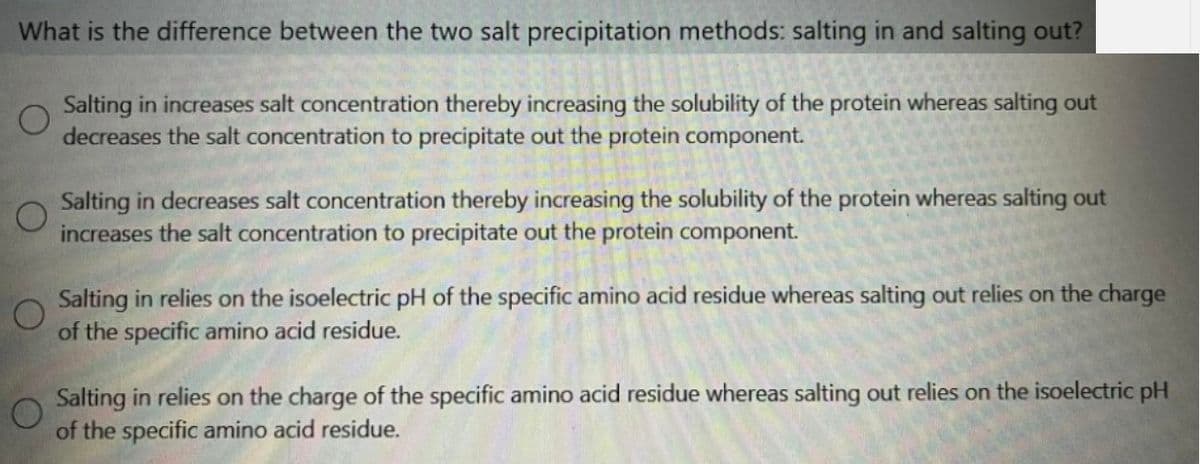What is the difference between the two salt precipitation methods: salting in and salting out? Salting in increases salt concentration thereby increasing the solubility of the protein whereas salting out decreases the salt concentration to precipitate out the protein component. Salting in decreases salt concentration thereby increasing the solubility of the protein whereas salting out increases the salt concentration to precipitate out the protein component. Salting in relies on the isoelectric pH of the specific amino acid residue whereas salting out relies on the charge of the specific amino acid residue. Salting in relies on the charge of the specific amino acid residue whereas salting out relies on the isoelectric pH of the specific amino acid residue.
What is the difference between the two salt precipitation methods: salting in and salting out? Salting in increases salt concentration thereby increasing the solubility of the protein whereas salting out decreases the salt concentration to precipitate out the protein component. Salting in decreases salt concentration thereby increasing the solubility of the protein whereas salting out increases the salt concentration to precipitate out the protein component. Salting in relies on the isoelectric pH of the specific amino acid residue whereas salting out relies on the charge of the specific amino acid residue. Salting in relies on the charge of the specific amino acid residue whereas salting out relies on the isoelectric pH of the specific amino acid residue.
Human Heredity: Principles and Issues (MindTap Course List)
11th Edition
ISBN:9781305251052
Author:Michael Cummings
Publisher:Michael Cummings
Chapter9: Gene Expression And Gene Regulation
Section: Chapter Questions
Problem 18QP: The following is a portion of a protein: met-trp-tyr-arg-gly-pro-thr-Various mutant forms of this...
Related questions
Question
100%

Transcribed Image Text:What is the difference between the two salt precipitation methods: salting in and salting out?
Salting in increases salt concentration thereby increasing the solubility of the protein whereas salting out
decreases the salt concentration to precipitate out the protein component.
Salting in decreases salt concentration thereby increasing the solubility of the protein whereas salting out
increases the salt concentration to precipitate out the protein component.
Salting in relies on the isoelectric pH of the specific amino acid residue whereas salting out relies on the charge
of the specific amino acid residue.
Salting in relies on the charge of the specific amino acid residue whereas salting out relies on the isoelectric pH
of the specific amino acid residue.
Expert Solution
This question has been solved!
Explore an expertly crafted, step-by-step solution for a thorough understanding of key concepts.
This is a popular solution!
Trending now
This is a popular solution!
Step by step
Solved in 2 steps

Recommended textbooks for you

Human Heredity: Principles and Issues (MindTap Co…
Biology
ISBN:
9781305251052
Author:
Michael Cummings
Publisher:
Cengage Learning

Human Heredity: Principles and Issues (MindTap Co…
Biology
ISBN:
9781305251052
Author:
Michael Cummings
Publisher:
Cengage Learning